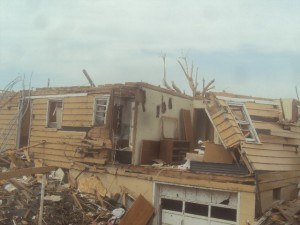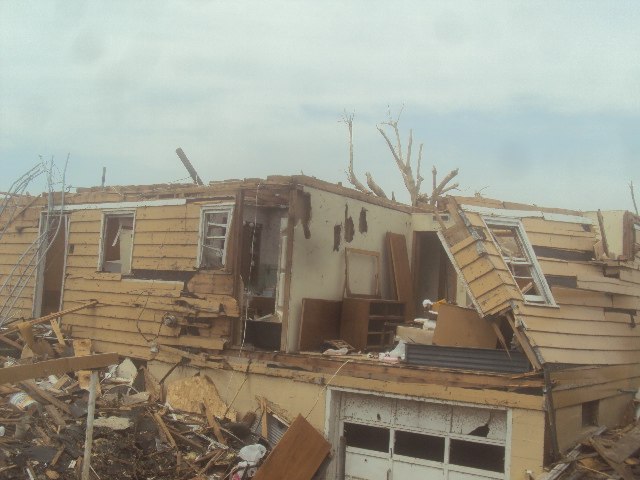“One of the eeriest things was … the lack of noise. There were no birds. There was no sound. There was no vegetation. There was nothing. There were no dogs. There were no cars. It was just mounds of rubble that ran 10 or 12 miles … and anywhere from a mile and a half to 2 miles wide,”
… said Steve Keeney, catastrophe response team adjuster for Shelter Insurance, describing the aftermath of the devastating EF-5 (Enhanced Fujita Scale) tornado with winds more than 200 mph that struck Joplin, Missouri, at 5:41 the evening of May 22, 2011.

Emergency responders from 14 states aided Missouri’s fourth largest city after the spring storm wiped out a third of the community, causing 161 deaths.
More than 500 residential properties, 35 miles of roadway and 700 city blocks were destroyed. Also, 1.2 million cubic yards of debris had to be cleared from 2,700 lots.
Police sought the help of insurance claims adjusters, cross-referencing policyholders making claims with their list of the missing.
Dean Welton, catastrophe claims field manager for the Madison, Wis.-based American Family, grew up in southern Missouri. He was on his way to visit field adjusters in Minnesota when he had to turn around and head back to Missouri. Having worked in the catastrophe department since 2003, he’s seen his fair share of devastation, but nothing prepared him for Joplin.
It took a day to drive down and another day to get to the scene due to access issues, Welton said. In addition to using its cat vehicle, his company set up shop in local agents’ offices. Many of the hotels were already booked with displaced homeowners, so the adjusters stayed in the neighboring towns of Springfield and Rogers, Ark.
“When I first arrived down there, a lot of the local office adjusters and local field management were at one of the offices up on the north side of Joplin,” Welton said. “Usually in other situations, in other tornadoes, you talk to one or two people that have lived through this traumatic situation but in Joplin, it was everybody you talked to. Everybody had felt the brunt of the storm.”
According to Welton, half the city was gone. He compared the scene to a war zone.
“It was just a situation that, again, in most tornadoes, you can see where a tornado hits a neighborhood or hits a certain area of the town, but usually, it’s pretty concentrated the damage is. But with Joplin, it was just like the whole city … a bomb had been dropped, and just blew. It was like you were watching CNN in a country that was experiencing warlike conditions, and not something a tornado would have happen. It was pretty mind-blowing,” Welton said. “I’ve been with the ‘cat’ department since 2003, so I’d worked several tornadoes, and several of them large, but nothing like this.”
Comparing an average catastrophe loss to Joplin, while it usually takes a half-day to locate the perimeter of the loss, it took almost three days because of access issues and the scope of the damage. Welton estimated that claims involving homes that were a total loss were resolved within 10 days to two weeks. Contents losses took longer. Normally, adjusters working catastrophe losses put in 12-hour days. In this case, American Family’s cat team worked 16- to 18-hour days.
American Family’s catastrophe response team processed nearly 2,300 claims and paid more than $100 million in property, auto and commercial claims.
Keeney, the adjuster with Shelter Insurance’s catastrophe response team, was already in the Joplin area handling hail claims when the skies began darkening that fateful Sunday.
“On Sundays, we typically work two or three claims,” Keeney said. “I was on my last one at about five o’clock, just a few miles north of Joplin. It had been an extremely hot and humid day. The humidity was so high that you just knew that it was eventually going to result in a rain. It was one of those things in the back of my mind I kept thinking, eventually once it comes, it’ll bring some relief to that humidity and knock it down a little bit. So along about four o’clock or so, I could see that the sky was getting dark, and the storm was coming in.
“I had just finished my last roof at about 4:30 or 5, and I was staying over in Springfield, Mo.,” Keeney continued. “Rather than come down and hit I-44 coming through the heart of Joplin, I decided to take some back county roads because the storm looked so dark that I thought I would avoid driving through the heavy rain and try and get ahead of it as I was heading east back towards Springfield. Then once I got back to Springfield at about 6:30 and turned the TV on, then [I] realized that what I had [seen] and what I was trying to get ahead of was in actuality the F5 tornado.”
Keeney put in 12-hour days and worked Joplin claims for seven months. “I was there right up until the week before Christmas, working three week straight rotation and then five days off, and then back for another three weeks,” he said.
“This thing was just like a tsunami of wind that just leveled everything in its path. There was no structure standing; 7,000 structures were leveled – businesses, hospitals, office complexes, apartments, sheds, garage, outbuildings, trees, shrubs. There was virtually nothing left standing,” Keeney said.
Elisabeth Sobczak, a trainer with property claims experience, drove Shelter Insurance’s storm van down to Joplin on Sunday evening. She was one of the first to arrive on the scene along with emergency medical personal.
“It didn’t seem chaotic. It just seemed like people were trying to get their world back,” Sobczak said.
She helped storm victims change tires, and provided food, water and even handed out trash bags so people could collect their belongings. “It would amaze you the value of a Hefty bag. Their possessions are just everywhere and those that were lucky enough to have it, still on their property … were trying to pick through the debris to see what they could salvage, and it was only what they could carry in their arms because they had no place to put it. People were crying, saying thank you because they at least had a place to start collecting their belongings,” she said.
Sobczak described holding Joplin residents who needed someone to listen and a shoulder to cry on.
“You hug people and you don’t let go. You let go when you feel them let go,” Sobczak said.
The day after, Sobczak described a big black wall cloud that unleashed a powerful rain and hail storm to the already weary Midwestern town. Joplin ended up being under a tornado watch most of the week after the initial tornado struck.
“For days on end it just kept looking like another tornado was going to fall out of the sky,” Sobczak said. “People … were just traumatized. Some people didn’t know where to begin. They were very thankful for their lives. There was anger in some.”
She described an 18- or 19-year-old girl whose mother was found underneath a car in her house. The teen had to identify her mom’s body. “Here’s a young lady who had to identify her mom,” Sobczak said. “It’s very sobering because it really brings to light people’s mortality.”
Larry Potalivo, a catastrophe adjuster with Crawford & Co., a global independent adjusting firm, was assigned to Joplin about two weeks after the EF-5 tornado struck. He stayed there for two months.
“I’ve never seen the kind of destruction that I’ve seen there. It was overwhelming,” he said.
In the hardest hit area, he saw there were very few homes with walls that were still standing. A hospital was destroyed.
“There was just no safe place to be in a house in an EF-5 tornado,” Potalivo said.
He described another incident where the powerful tornado threw a car into a family home.
“There was a man and his 30-year-old son, and they were in their house. They heard the noise, that freight train sound that everybody talks about,” Potalivo said. “He grabbed his son and they ran down to the basement, and the next thing he knew his son was pulling him out from underneath the car that had come through their house and into their basement.”
Both miraculously survived with minor injuries.
Potalivo described the glazed look in the eyes of survivors, which he likened to that seen in soldiers who have suffered through battles with fatal consequences.
Potalivo spent two hours with a distraught 74-year-old widow who never dealt with insurance matters before. He sat down with her under a tree and just let her talk through the ordeal.
“I get a lot of satisfaction out of helping these people and seeing the look in their eyes when they realize that I actually care about their lives and are trying to get them back together again,” Potalivo said. “That goes a long way to being successful in this business in that when people feel that you care about them, they are going to be much more inclined to be appreciative and to let their agents and their insurance companies know that this person went out of their way to help me out. It makes me do a better job and makes for a better situation.”
The tornado was the largest insurance event in state history, according to Missouri Insurance Director John Huff. The final payout on insured losses will be just shy of $2 billion. Slightly more than $1 billion had been paid within just 100 days after the tornado struck.
“The claims in the personal lines private passenger auto and homeowner claims, those are very close to final resolution. Some of the commercial claims take longer to resolve,” Huff explained.
That schools opened in time for the fall semester was a sign of the spirit and dedication of Joplin residents, Huff said.
To recognize the city’s rebuilding efforts, President Obama is expected to give the commencement speech to Joplin High School’s 2012 graduating class.
Was this article valuable?
Here are more articles you may enjoy.


 Property Restoration Industry: A Culture in Need of Repair?
Property Restoration Industry: A Culture in Need of Repair?  Dog-Related Injury Claim Payouts Hit $1.12B in 2023, Report Shows
Dog-Related Injury Claim Payouts Hit $1.12B in 2023, Report Shows  Synopsys Sued by Private Equity Firm for Shopping $3 Billion Unit
Synopsys Sued by Private Equity Firm for Shopping $3 Billion Unit  California Chiropractor Sentenced to 54 Years for $150M Workers’ Comp Scheme
California Chiropractor Sentenced to 54 Years for $150M Workers’ Comp Scheme 